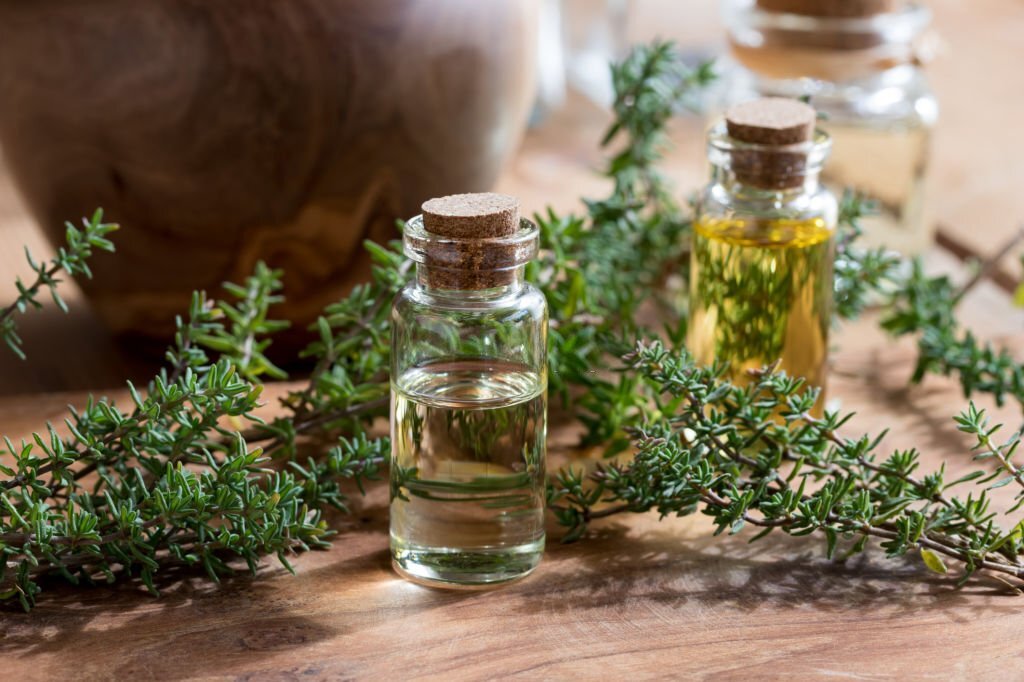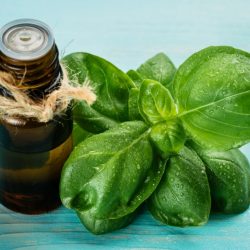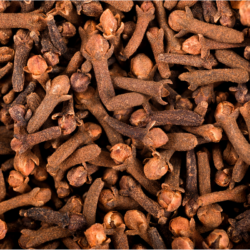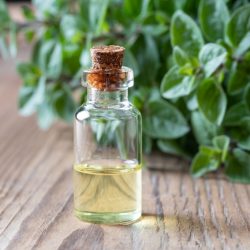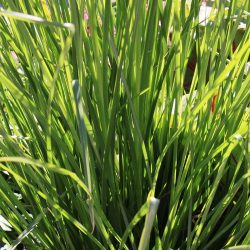Thujanol Thyme, whose botanical name is Thymus vulgaris ct thujanol, belongs to the Lamiaceae family. Its essential oil is obtained from its aerial flowering parts.
History of Thyme
A medicinal and culinary plant, thyme(Thymus vulgaris) grows throughout the Mediterranean region, where it is intensively cultivated. It is the dried leaves and flowers that contain the active ingredients, particularly essential oils. Thymus (its current Latin name) comes from the Greek thymos. In ancient times, all sorts of small, fragrant plants in the Lamiaceae family were known by this name. The Greek word thuô refers to offerings to the gods. Finally, the Greek word thumus evokes courage.
Today, the word thyme has been stable in this form since the 13th century. For some of our contemporaries, it seems to be associated with a gland called the thymus. We know that the ancient Greeks located the soul in this organ. Traditionally, thyme aids digestion and combats bloating and flatulence. In the event of a cold or bronchitis, it also clears the respiratory tract and soothes coughs.
Egyptian antiquity
This plant was used along with others (savory, frankincense, myrrh, etc.) in the ritual of mummification. To draw a parallel, today thyme and savoury are used to cure pheasant game. Antiseptic and antibacterial, thyme stops the proliferation of bacteria. It has also improved the preservation of mummies, some of which have survived to this day. This is proof of the Egyptians’ knowledge of the subject. Beyond the fragrance of the plants used for embalming (plants from which we later learned to extract the essential oil they contain), the embalmers had an in-depth knowledge of their medical properties. An essential oil does not camouflage a bad smell with its perfume, it destroys it. We now know that many unpleasant odours are caused by the degradation of organic matter.
The Egyptians used to make ointments with thyme to embalm the dead. In the Middle Ages, witches made love potions with this plant. In ancient times, it was burnt to purify the air, perfume water and ward off pathogens. It could also be used to give soldiers strength and knights courage. Today, the scientific community agrees that its virtues are due to its high thymol content, a molecule frequently used to make soaps and cosmetics. It is one of the most recommended natural treatments for coughs and respiratory infections.
Greco-Roman antiquity
Thyme has also been a much-loved aromatic since ancient times.
Over a period of almost 1,000 years, there are numerous traces of thyme being used as a condiment, but above all for medicinal purposes. First Hippocrates, then Theophrastus, who distinguished between medicinal white thyme and black thyme, capable of corrupting the body and causing bile(melancholy). These names reflect the fact that the ancients often took this type of signature into account. The same was true of henbane, for example. Sometimes, it was other types of characteristics that attributed different sexes to the same plant. For example, it was long thought that there were male and female mandrakes. Dioscorides and Pliny then took up this nomenclature but added notes relating to the properties of thyme (cough suppressant, expectorant, blood thinner, gastrointestinal tonic).
Pliny was perhaps the first to mention thyme’s warming properties. Galen used thyme to ease childbirth, while later, in the 5th century, a Greek physician by the name ofAetius gave highly relevant information on the effect of thyme on the psyche: he prescribed it for those with a troubled mind, choleric people and melancholic people. We’ll see later how the observations of the Ancients were full of common sense, but not before indicating how the Greeks and Romans used thyme: in an invigorating bath, as a dry fumigation to purify the air, as a poultice, anointing and massage..
Thyme is native to Europe and southern regions. An aromatic, condiment and medicinal plant par excellence, the use of thyme goes back to the dawn of time. In Ancient Greece, thyme was burnt as incense before the altars of the gods. Finally, thyme is firmly rooted in the culinary customs of Provence: herbes de Provence, bouquet garni, dishes in sauce, grilled meats, thyme liqueur.
Middle Ages
Thyme was introduced outside its native region by monks in the 11th century. This late introduction explains its absence from the Capitular of Villis. But it did not escape the notice of Albert the Great and Hildegard of Bingen in particular. Hildegarde de Bingen was well aware of its character: “thyme, if added to other good herbs and condiments, removes the putrefaction of diseases thanks to its warmth and strength”, as long as it is properly channelled. An anti-putrid, thyme was used by the abbess to treat ulcers, leprosy, “bad humours”, joint and muscle pain, lice, etc. Like the Greeks and Romans, she used thyme in medicinal baths, which were highly prized in the Middle Ages, as well as in plasters and decoctions.
Arab medicine(Ibn al-Baytar, 13th century) reports that thyme purifies the stomach and liver, fights colic and mouth and throat ailments, fortifies the kidneys and stimulates copulation. Saint Hildegarde (12th century) used it against leprosy, paralysis and lice. In the 19th century, it was used as a stimulant, to boost digestive functions and also to combat nervous fatigue.
Renaissance and modern period
Although Matthiole makes almost no mention of thyme, it can be found in Paracelsus ‘ Opodeldoch balm (1541) and later in the so-called “tranquil” balm (around the end of the 17th century). At the same time, Louis XIV used this substance to relieve toothache. Nicolas Lémery described it as a cerebral tonic, a digestive agent and an antitoxin. He agreed with Galen that it could also facilitate childbirth.
Known since at least the 16th century, thyme essential oil is gradually revealing its secrets. One of its active ingredients, thymol, was discovered as early as 1719. But it was especially at the dawn of the 20th century that everything gathered pace. This oil was studied in 1887 by Chamberland, who demonstrated its bactericidal action on anthrax. In 1889, Cadéac and Meunier got their hands dirty by working on the question of the action of essential thyme oil on the typhoid bacillus. In 1894, Mequel demonstrated the bactericidal properties of thyme vapours. It was Morel and Rochaix ‘s turn in 1921-1922 to demonstrate other actions on meningococcus, Eberth’s bacillus, diphtheria bacillus and staphylococcus.
In the 1930s, Dr Henri Leclerc, in his Précis de phytothérapie, took up the ancient prescriptions of the Ancients. Among other things, he wrote that thyme helps to restore physical and moral strength. Modern authors(Fournier, Valnet, Bardeau, Franchomme, Faucon…) continued to refer to thyme until it reached us today after a journey spanning thousands of years.
Contemporary times
Fournier (20th century) sums up its actions: tonic, stomachic, pectoral, antispasmodic and emmenagogue.
The infusion is recommended orally for whooping cough and chronic bronchitis, and as a compress for swelling and rheumatic pain. It is used in therapeutic baths as a tonic. People also place it in wardrobes to keep insects away.
In aromatherapy, the essential oil is traditionally used for intestinal and urinary tract complaints, as a stimulant and against worms. Valnet (20th century) recommended it for pulmonary and intestinal ailments, whooping cough and intestinal parasites such as roundworms, taenias and pinworms.
Much more often found in the kitchen than in the medicine cabinet, thyme is one of those plants with a distant past, like so many around the Mediterranean. Even if its sacred nature is not immediately obvious, unlike sage and rosemary, the fact remains that illustrious ancients had dealings with it.
First of all, etymology offers us some interesting clues to which thyme can be linked:
- Thymus – its current Latin name – comes from the Greek thymos. In ancient times, this was the name given to various small, fragrant plants in the Lamiaceae family.
- Thymos was thought to have something to do with perfume, as people used to burn thyme in order to smoke it.
- Secondly, the Greek word thuô refers to sacrifices offered to the gods (perhaps in connection with the previous point).
- Finally, the Greek word thumus evokes courage
Today, the word thyme, stabilised in this form since the 13th century, seems to some of our contemporaries to have a connection with the gland known as the thymus. We know that the ancient Greeks located the soul in this organ.
What are the pharmacological properties of Thyme ct thujanol essential oil?
Known or presumed mode of action :
- Immuno-stimulation
- In vitro (in the test tube), thyme essential oil and thymol have an antiseptic action on germs such as Helicobacter pylori (responsible for duodenal ulcers) and microscopic fungi responsible for mycosis.
Antimicrobial effect :
Thyme essential oil is a powerful antiviral, anti-infective, bactericide, virucide and fungicide. It is thought to be more specific for gynaecological infections.
Immunostimulant effect:
As an immunostimulant, thyme essential oil increases immunoglobulin A and stimulates and regenerates hepatocytes.
Other effects:
- Neurotonic, balancing (active on the central nervous system and autonomic nervous system)
- Activates blood circulation, warms locally
Forms and dosage of thyme :
The usual dosage is 1 to 2 g of dried plant per cup of boiling water, as an infusion, several times a day, or the equivalent in fresh herb. When taken as a liquid extract (syrup), the dosage is calculated according to the concentration of active ingredients.
Thyme tea or a drop of essential oil diluted in a bowl of hot water can also be used for inhalation to clear the respiratory tract. More concentrated infusions (5g of dried plant per 100ml of water) are used as a gargle or mouthwash.
Mixtures of thyme leaves and primrose root should be used as recommended in the product leaflet.
Some other expectorant plants:
Traditional herbal medicine also uses the following plants to relieve the symptoms of bronchitis:
-
- Eucalyptus(Eucalyptus globulus)
- Ivy(Hedera helix)
- Niaouli(Melaleuca quinquenervia)
- Scots pine(Pinus sylvestris)
- Primrose(Primula eliator, P. veris, P. vulgaris)
- Wild thyme (Thymus serpyllum)
Does Thyme ct thujanol essential oil require any precautions for use?
- Not recommended for pregnant or breast-feeding women.
- Dermocaustic in its pure state, dilution is required by the skin.
- Beware of possible gynaecomastitising effects with prolonged use. Linalool inhibits the production of testosterone, and should not be used long-term by males as an endocrine disrupter.
- Not recommended for children under the age of 7.
- Caution in cases of renal insufficiency per os (nephrotoxic).
- Do not combine with cortisone, as there is a risk of drug interaction. Ask your pharmacist for advice.
Is thyme essential oil an effective remedy for scabies?
Thyme essential oil is recognised for its antiparasitic, antifungal and antibacterial properties. It is often used in the natural treatment of various skin conditions, including scabies.
However, it is important to note that htym essential oil should not be used on its own to treat scabies. It is best used in conjunction with other natural remedies and in consultation with a healthcare professional. To use htym essential oil to treat scabies, you can dilute it in a carrier oil such as coconut or sweet almond oil. Then apply this mixture to the affected areas of the skin.
However, it is essential to take precautions when using essential oils.Htym essential oil can cause allergic reactions in some people. It is therefore advisable to carry out a skin test beforehand by applying a small diluted quantity to a small area of skin and observing any adverse reactions before using it more widely. It is also important to note that scabies is a medical condition and it is advisable to consult a healthcare professional for an accurate diagnosis and appropriate treatment. Although some natural remedies may provide some relief from symptoms, full medical treatment is usually required to completely eliminate the infection.
What the health authorities think:
THE EMA
The European Medicines Agency considers thyme to be “traditionally used as an expectorant, for coughs and colds”. It recommends reserving its use for adults and children over the age of twelve.
It also considers that mixtures of thyme leaves and primrose root (Primula veris or P. elatior) can be used either “for a medically well-established use against coughs” (in the case of the expectorant properties of products with marketing authorisation), or for “traditional use against coughs associated with colds” in the case of products without marketing authorisation. Thyme- and primrose-based products with marketing authorisation are reserved for adults.
THE WHO
The World Health Organisation recognises the use of thyme “against dyspepsia (difficult digestion) and other gastrointestinal disorders, against coughs during colds or bronchitis, and as a gargle against laryngitis and inflammation of the tonsils”. As a topical application, thyme is said to have antiseptic and healing properties for superficial skin wounds and mouth irritations.
THE E
Commission E of the German Ministry of Health recognises the use of thyme in “bronchitis and productive coughs (which produce mucus), as well as colds”.
ESCOP
The European Scientific Cooperation on Phytotherapy recognises the use of thyme “in catarrh of the upper airways, as a complementary treatment in the treatment of whooping cough, and to relieve mouth irritations and bad breath”.
Medical bibliographical sources and clinical trials:
- Schmidt E, Wanner J, Hiiferl M, Jirovetz L, Buchbauer G, Gochev V, Girova T, Stoyanova A, Geissler M. Chemical composition, olfactory analysis and antibacterial activity of Thymus vulgaris chemotypes geraniol, 4-thujanol/terpinen-4-ol, thymol and linalool cultivated in southern France. Nat Prod Commun. 2012
- Kotan R, Kordali S, Cakir A. Screening of antibacterial activities of twenty-one oxygenated monoterpenes. Z Naturforsch C J Biosci. 2007
- M. N. Gallucci, M. Oliva, C. Casero, J. Dambolena, A. Luna, J. Zygadlo, M. Demo. Antimicrobial combined action of terpenes against the food-borne microorganisms Escherichia coli, Staphylococcus aureus and Bacillus cereus. Flavour and Fragrance Journal

